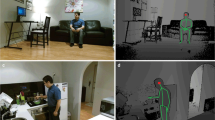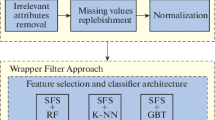Abstract
Fall causes serious perils for the elder people when they are living alone. A mathematical model, optimized ANFIS using frequent pattern mining (OAFPM) for activity recognition, is proposed in this paper, which uses fuzzy inference system, adaptive neural network and frequent pattern mining (FPM) to identify the activity of a person accurately. Accelerometer values are given as input to the proposed model in real time which forms the premise part of the model, whereas the consequence is defined by the rules generated out of input and output linear relation. Initial rule identification is done through membership functions of each activity, and the number of rules is reduced using FPM approach. During the learning phase, the optimal premise parameters are selected using gradient descent method and the choice of consequent parameters is based on the least-square estimation method. The optimal values of premise and consequent parameters along with the reduced rule matrix made the OAFPM model to achieve an accuracy rate of 95.8\(\%\) and also reduce the computational complexity by triggering less number of nodes for each activity.








Similar content being viewed by others
References
Aggarwal JK, Ryoo MS (2011) Human activity analysis: a review. ACM Comput Surv (CSUR) 43(3):16
Al-Hmouz A, Shen J, Al-Hmouz R, Yan J (2012) Modeling and simulation of an adaptive neuro-fuzzy inference system (ANFIS) for mobile learning. IEEE Trans Learn Technol 5(3):226–237
Bulling A, Blanke U, Schiele B (2014) A tutorial on human activity recognition using body-worn inertial sensors. ACM Comput Surv (CSUR) 46(3):33
Chae J, Jin Y, Wen M, Zhang W, Sung Y, Cho K (2018) Genetic algorithm-based adaptive weight decision method for motion estimation framework. J Supercomput 1–13
Cheng BC, Tsai YA, Liao GT, Byeon ES (2010) HMM machine learning and inference for activities of daily living recognition. J Supercomput 54(1):29–42
Dempe S, Ruziyeva A (2012) On the calculation of a membership function for the solution of a fuzzy linear optimization problem. Fuzzy Sets Syst 188(1):58–67
Gaglio S, Re GL, Morana M (2015) Human activity recognition process using 3-D posture data. IEEE Trans Hum Mach Syst 45(5):586–597
He Z, Jin L (2009) Activity recognition from acceleration data based on discrete consine transform and SVM. In: IEEE International Conference on Systems, Man and Cybernetics, 2009, SMC 2009. IEEE, pp 5041–5044
He ZY, Jin LW (2008) Activity recognition from acceleration data using AR model representation and SVM. In: International Conference on Machine Learning and Cybernetics, 2008, vol 4. IEEE, pp 2245–2250
Hemalatha CS, Vaidehi V, Lakshmi R (2015) Minimal infrequent pattern based approach for mining outliers in data streams. Expert Syst Appl 42(4):1998–2012
Hu N, Englebienne G, Lou Z, Kröse B (2017) Learning to recognize human activities using soft labels. IEEE Trans Pattern Anal Mach Intell 39(10):1973–1984
Igual R, Medrano C, Plaza I (2015) A comparison of public datasets for acceleration-based fall detection. Med Eng Phys 37(9):870–878
Jang JS (1993) ANFIS: adaptive-network-based fuzzy inference system. IEEE Trans Syst Man Cybern 23(3):665–685
Jang JS (1996) Input selection for ANFIS learning. In: Proceedings of the 5th IEEE International Conference on Fuzzy Systems, 1996, vol 2. IEEE, pp 1493–1499
Kang J, Kim J, Lee S, Sohn M (2018) Transition activity recognition using fuzzy logic and overlapped sliding window-based convolutional neural networks. J Supercomput 1–18
Khan AM, Lee YK, Lee SY, Kim TS (2010) A triaxial accelerometer-based physical-activity recognition via augmented-signal features and a hierarchical recognizer. IEEE Trans Inf Technol Biomed 14(5):1166–1172
Li C, Lin M, Yang LT, Ding C (2014) Integrating the enriched feature with machine learning algorithms for human movement and fall detection. J Supercomput 67(3):854–865
Li F, Shirahama K, Nisar MA, Köping L, Grzegorzek M (2018) Comparison of feature learning methods for human activity recognition using wearable sensors. Sensors 18(2):679
Poorani VD, Ganapathy K, Vaidehi V (2012) Sensor based decision making inference system for remote health monitoring. In: International Conference on Recent Trends in Information Technology (ICRTIT), 2012. IEEE, pp 337–342
Ramasamy Ramamurthy S, Roy N (2018) Recent trends in machine learning for human activity recognition—A survey. Wiley Interdiscip Rev Data Min Knowl Discov 8(4):e1254
Takagi T, Sugeno M (1985) Fuzzy identification of systems and its applications to modeling and control. IEEE Trans Syst Man Cybern 1:116–132
Turaga P, Chellappa R, Subrahmanian VS, Udrea O (2008) Machine recognition of human activities: a survey. IEEE Trans Circuits Syst Video Technol 18(11):1473
Twomey N, Diethe T, Fafoutis X, Elsts A, McConville R, Flach P, Craddock I (2018) A comprehensive study of activity recognition using accelerometers. In: Informatics, vol 5, issue 2. Multidisciplinary Digital Publishing Institute, p 27
Van Kasteren T, Englebienne G, Kröse BJ (2010) Activity recognition using semi-Markov models on real world smart home datasets. J Ambient Intell Smart Env 2(3):311–325
Vrigkas M, Nikou C, Kakadiaris IA (2015) A review of human activity recognition methods. Front Robot AI 2:28
Ye W, Xiang-yu B (2013) Research of fall detection and alarm applications for the elderly. In: Proceedings 2013 International Conference on Mechatronic Sciences, Electric Engineering and Computer (MEC). IEEE, pp 615–619
Zendehboudi A, Li X, Wang B (2017) Utilization of ANN and ANFIS models to predict variable speed scroll compressor with vapor injection. Int J Refrig 74:475–487
Acknowledgements
The work is funded by NRDMS, Department of Science and Technology, Government of India, New Delhi, and Centre for Research, Anna University. Also, the first author acknowledges her financial support provided by Anna University through visvesvaraya fellowship.
Author information
Authors and Affiliations
Corresponding author
Additional information
Publisher's Note
Springer Nature remains neutral with regard to jurisdictional claims in published maps and institutional affiliations.
Rights and permissions
About this article
Cite this article
Marimuthu, P., Perumal, V. & Vijayakumar, V. OAFPM: optimized ANFIS using frequent pattern mining for activity recognition. J Supercomput 75, 5347–5366 (2019). https://doi.org/10.1007/s11227-019-02802-z
Published:
Issue Date:
DOI: https://doi.org/10.1007/s11227-019-02802-z




